Alexandria Lighthouse - the most interesting thing in blogs. Zeus statue in Olympia
We have all heard about the seven wonders of the world, but few people know that there is a version according to which the wonders of the world in ancient history there was more. Seven - for the ancient Greeks, as well as in many other cultures - a mystical number. Therefore, the seven wonders of the world (as well as the seven wise men) were “shuffled.”
Later and more perfect wonders of the world replaced some earlier and, often, less perfect wonders of the world from the list, since increasing the number of wonders of the world was impossible - the authors needed to keep within the magic seven wonders. However, the author of this article will proceed from the classical (most recent) list of miracles. It is also not entirely correct to talk about the “eighth wonder of the world.” The term is applied to many later structures. However, the “Seven Wonders of the World” is a primarily historical term and the “magnificent seven”, as one of the attributes of ancient Greek culture (culture in the broad sense of the word, since some of the wonders of the world were not built by the Greeks) will forever remain in that era. Only one of the wonders of the world - the Cheops pyramid, still amazes us with its grandeur, as if a tangible bridge between our time and the ancient world. This article is a short excursion into history, telling about the “Seven Wonders of the World”. The journey begins:
Some publications list the Egyptian pyramids as the first wonder of the world, but this is not true. Greek authors never called a group of structures a wonder of the world. And the pyramids are no exception. Despite the fact that the Greeks knew that there were several large pyramids, they proclaimed the largest one, the Pyramid of Cheops, a wonder of the world. The pyramids were built as tombs of the pharaohs - the rulers of Egypt. According to the official historical version, the Cheops pyramid was built in the 27th century. BC. It’s paradoxical, but only this, the oldest of the wonders of the world, has survived to this day. The name of the architect of the pyramid, Hemiun, has also been preserved. The dimensions of the pyramid are as follows: height - 146.6 m, length of each side - 233 m. It is made of carefully hewn limestone blocks weighing from 2.5 to 30 tons. According to scientists, approximately 2,300,000 such blocks were required for its construction. The pyramid is oriented to the cardinal points. Even the ancient Greeks and Romans considered the pyramids only a monument to the vanity of the pharaohs, who doomed thousands of builders to death and unbearable hardships. However, most likely the construction of the pyramid had a deep cult and religious meaning, and was carried out by free citizens during a period when there was no agricultural work. To be fair, it is worth noting that many scientists (physicists, mathematicians) dispute official version- the time of construction of the pyramid is questioned (it is argued that it is even older), the connection of the pyramid with Pharaoh Cheops, its purpose (there are versions that the pyramids were not tombs, but temples, observatories, etc.).
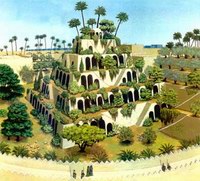
The Hanging Gardens of Babylon were built by the Babylonian king Nebachadnezzar II for his wife, the Median princess Babylon, who missed the mountainous and forested nature of Media in desert and flat Babylon. Date of construction - 6th century BC. Architect unknown. The Hanging Gardens were a tower consisting of four tiers - platforms that supported columns up to 25 m high. The height of the gardens was thus about 100 meters. The surface of each platform was covered with a layer of reeds mixed with asphalt, then reinforced with two layers of brick held together with gypsum mortar, on top of which lead slabs were laid, through which water could not seep into the lower tiers. On the platforms lay fertile soil on which various herbs, flowers, shrubs, and trees grew. In the cavity of one of the columns there were pipes through which water from the Euphrates was supplied to the tiers of the gardens around the clock. There are different versions regarding the technical design of water supply for gardens. IN hanging gardens Semiramis in 339 BC. Alexander the Great, who captured Babylon eight years earlier, died. After his death, Babylon, and after him the gardens, fell into decay. Powerful floods and time gradually destroyed this wonder of the world.
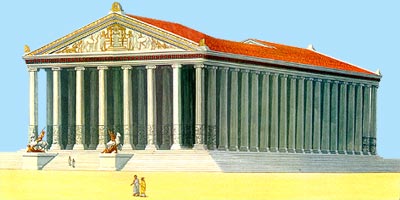
The cult of veneration of Artemis existed at the site of the Temple much earlier; some researchers attribute its origin to pre-Greek times. According to legend, Artemis was born in this place. The temple of the goddess was built in the 6th century. BC e. architect Khersiphron and became one of the most revered centers of pilgrimage of the ancient world. July 21, 356 BC e. The temple of Artemis of Ephesus was burned by Herostratus. After 25 years the temple was restored in original form by order of Alexander the Great. The construction was led by architect Alexandra Deinokrat. The temple occupied an area of 110 x 55 m, the height of the columns (there were 127 of them), in a double row surrounding the structure, was about 18 m; The roof of the temple was covered with marble tiles. Many famous Greek masters took part in the construction and decoration of the Temple. In 263, the Goths invaded Asia Minor and plundered the sanctuary. The prohibition of pagan cults in the Roman Empire in 391 (by Emperor Theodosius I) dealt a new blow to the sanctuary. However, despite the prohibitions, the cult of Artemis continued to exist in this place for about two centuries. It was subsequently destroyed by fanatical Christians.

In 456 BC. e. V greek city Olympia, a temple dedicated to Zeus (the supreme Greek god) appeared, which became the main shrine of the city. The temple was decorated with a statue of Zeus 12 (according to other sources 17) meters high, made by the famous Greek sculptor Fidia. During the construction of the statue, ivory, gold, gems, valuable wood species. Phidias depicted Zeus sitting on a throne, with an olive wreath on his head. This sculpture, undoubtedly, was included in the list of wonders of the world not because of its size (relatively modest) but because of the skill of the sculptor. At the end of the 4th century. - early 5th century n. e. The Byzantines transported the statue to Constantinople. In the 5th century n. e. the statue died in a fire at the hippodrome where it was installed (according to other sources, the statue died in a fire in the imperial palace).
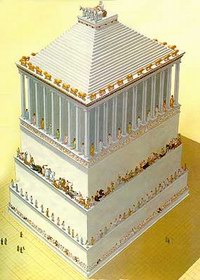
Actually, the very word Mausoleum comes from the name of this wonder of the world - the tomb of the King of Caria - Mausolus (died in 353 BC). According to one version, the tomb was built by the king’s wife (later also buried in it) - Artemisia; according to another, the construction of the tomb began during his lifetime. The architect of the tomb is unknown. The tomb of Mausolus was built of brick and lined inside and outside with white marble. Its height reached 60 m. The first floor, where the urn with ashes was located (the corpses were cremated), looked like a cube 20 m high and an area of 5 thousand square meters. m. The second floor was surrounded on the outside by a colonnade. Sacrifices were kept here. The next floor was made in the form of a pyramid, which was crowned with the figures of Mausolus and Artemisia driving a chariot drawn by four horses (quadriga). The mausoleum existed for approx. 1800 years. For many centuries it stood in the middle of a city that was deserted by that time. In 1522, the Mausoleum was dismantled by the crusaders, who strengthened their fortress on the Aegean Sea - the castle of St. Petra.
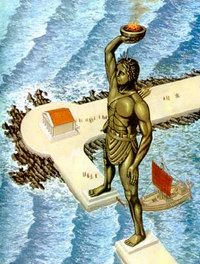
The decision to build a sculpture of the god Helios (according to legend, the creator and patron of the island) was made by the inhabitants of the island of Rhodes in 304. BC. The statue was built in honor of the victory over the troops of the ruler of Western Asia, Demetrius Poliorcetes, who tried to capture the island. Under the leadership of architect Hares, construction lasted 12 years. The statue was created from stone and decorated with bronze sheets. It towered at the entrance to the harbor of Rhodes and was visible from neighboring islands, the height of the statue was approx. 35 m. The life of this wonder of the world was the shortest of all. A little more than 50 years later, in 220 BC. e. The statue collapsed during an earthquake. The remains of the Colossus lay on the ground for more than a thousand years. In 977, they were sold by the Arabs who captured Rhodes to a wealthy merchant, who loaded 900 camels with them.
7. Faros lighthouse
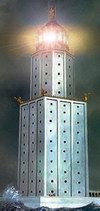
The Pharos lighthouse was built under the ruler of Egypt Ptolemy I (3rd century BC) on the island of Pharos located in the Nile Delta, not far from Alexandria, the capital of Egypt at that time. The architect of the lighthouse was Sostratos. The height of the lighthouse is 135 m, its light was visible at a distance of 60 km (according to other evidence, up to 100 km). The lower part was a tetrahedral prism 60 meters high with a square base, the side length of which was 30 m (with an area of 600 sq. m.). In interior spaces inventory was stored, and the roof, decorated at the corners with statues of Triton, served as the base of the middle part. It was a 40-meter octagonal prism tower, lined with white marble. The upper (third) part of the lighthouse was built in the form of a cylindrical colonnade - 8 columns carried a dome topped with a 7-meter bronze figure of the ruler of the seas, Poseidon. The source of light was a constantly burning large fire. How the brightness and range of the glow was achieved is unknown. According to one version, this effect was achieved with the help of huge mirrors made of polished bronze or glass. On the other hand, thanks to the use of transparent polished stones - lenses. The flammable material was delivered via a spiral staircase located inside the lighthouse. It should be noted that Alexandrian lighthouse- the only wonder of the world that performed (for the most part) not a religious and aesthetic, but a practical function. For many centuries, he showed sailors the way to the Alexandrian harbor. The lighthouse was almost completely destroyed in May 1100 during a strong earthquake. Currently, only the base of the lighthouse, built into the medieval fortress, has been preserved.
Do you want to add some uniqueness to your office? The famous architect Massimo Bellunato will tell you how to transform and create a project for a future building. More detailed information can be found on the website http://venetoartdesign.it.
Noble Cretan Ghoul Inquisitor.
In principle, the topic is known, but I’m posting it for the sake of modern reconstructions of these wonders of the world
1. Statue of Zeus at Olympia.
The ancient Greek city of Olympia, located in the northwestern part of the Peloponnese, was a religious center, a place of cult of the supreme god of the ancient Greeks Zeus and the Olympic Games dedicated to him,
It was the greatest art center Ancient Greece. Architectural ensemble Olympia mainly developed in the 7th - 4th centuries BC. Magnificent temples of the gods, large and small, were erected here.
There was also one of the seven wonders of the world - the Statue of Olympian Zeus - the famous statue of the king of gods and people by the great Greek sculptor Phidias.
The statue was placed in the cult center of the Olympic sanctuary - the Temple of Zeus, in sacred grove Altise
When asked by the artist Panen how he (Phidias) planned to represent the supreme god, the master replied:
“...Just as Zeus is presented by Homer in the following verses of the Iliad:
Rivers, and as a sign Zeus waves his black eyebrows:
Kronid's fragrant hair quickly rose up
Around the immortal head; and the many-hilled Olympus shook.”
Phidias executed the statue using the chrysoelephantine technique:
the exposed parts of the body were lined with ivory plates, the robes were cast in gold, and the base of the sculpture was wooden.
The statue was huge - the height of the statue reached approx. 17 m.
The base of the statue was 6 meters wide and 1 meter high.
According to the reconstruction of archaeologist F. Adlel, the armrests of the throne and the palm of the right hand of Zeus with the figure of Nike (a symbol of victory) were at the height of the capillas of the columns of the second tier
As Strabo noted, “If God had stood up, he could have broken through the roof with his head.”
Zeus's eyes were the size of an adult's fist.
Travelers who saw Zeus in Olympia call the combination of power and mercy, wisdom and kindness in his face amazing.
"God sits on a throne, his figure is made of gold and ivory,
on his head is a wreath made of olive branches,
on his right hand he holds the goddess of victory, also made of ivory and gold. She has a bandage and a wreath on her head.
In the left hand of the god is a scepter decorated with all kinds of metals. The bird sitting on the scepter is an eagle.
God’s shoes and outerwear are also made of gold, and on the clothes there are images of various animals and lilies of the field.”
(Pausanias. “Description of Hellas” V. XI. 1-10)
The richest throne of Zeus was also made.
The back, armrests and foot were decorated with ivory reliefs, golden images of the gods and goddesses of Olympus, and near each leg of the throne - images of dancing Nikas.
The barriers surrounding the throne were painted by Phidias's brother, the artist Panen, who worked together with the great master.
Among the images in Paten's paintings, Pausanias mentions Atlas holding the vault of the sky, Hercules, Theseus and Perithous;
He also writes about the figures of Hellas and Salamis with ship prows in their hands, about Hercules defeating the Nemean lion.
The throne of Olympian Zeus was decorated with reliefs with scenes of the death of Niobe’s daughters: in the center is a mother protecting her daughter from the arrows of the gods, and to the left and right are the agonizing victims of Apollo and Artemis in various poses.
At the top of the throne were depicted Charites and Mountains.
On the bench under the feet of Zeus there is a modest inscription carved -
"Phidias, son of Charmides, an Athenian, created me."
In front of the pedestal of the statue, the floor was covered with dark blue Eleusinian stone; a basin carved into it for olive oil was supposed to protect the ivory from drying out.
The light that penetrated the doors of the dark temple, reflected from the smooth surface of the liquid in the pool, fell on the golden clothes of Zeus and illuminated his head; to those who entered it seemed that the radiance emanated from the very face of the deity.
The image of Zeus has undergone several restorations at different times; in particular, in the Hellenistic era (in the 2nd century BC) it was restored by the sculptor Dimophon from Messene.
Under Julius Caesar it was renovated after being damaged by lightning.
There were also attempts to steal individual parts of the sculpture: for example, Lucian writes about the disappearance of two golden locks, and Pausanias writes about the theft of an athlete’s figure (someone fell in love)
Little is known about the further fate of Phidias’s outstanding work. After 384, information about him disappears.
Later, the Byzantine historian Kedren reported that the statue was in one of the palaces of Constantinople in 475 and burned down during a fire. 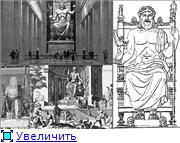
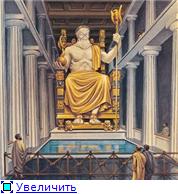
2. Colossus of Rhodes.
To capture the city of Rhodes, the king of Phrygia, Demetrius Piliorcetes, ordered the construction of a huge, 30-meter-high siege tower on wheels, heleopolis ( the last word military equipment - with rams and a drawbridge, catapults, platforms for landing, which was set in motion by 3,400 soldiers). The besiegers managed to break through the city wall.
The frightened Rhodians, falling to their knees, appealed to the patron of the city, the sun god Helios, promising to erect his statue higher than the siege tower. Either Helios in heaven really heard them, or someone on earth tried, but by morning a deep hole was dug in front of the fortress tower. The ill-fated tower collapsed into it. King Demetrius had no choice but to make peace with the Rhodians.
Having got rid of the misfortune, the inhabitants of Rhodes in 302 BC. e. began to build a statue of Helios. This work was entrusted to the famous sculptor Chares, a student of Lysippos. To work on the giant statue, the master used a clever technique: he surrounded the construction site with an earthen embankment.
The statue was constructed from bronze parts attached to an iron frame. The “assembly” was carried out from the bottom up - first the feet were formed, then the calves, etc. As the sculpture “grew”, the earthen hill around it also rose. Upon completion of the work, the hill was razed, and the statue in all its glory appeared before the amazed inhabitants of the island.
The construction of the Colossus was completed ca. 280 BC
Dimensions and description of the colossus:
The production of the grandiose monument required 500 talents of bronze and 300 talents of iron (13 and 8 tons, respectively).
The full statue was filled with stones and clay as it grew to make it more stable. The base was made of marble.
The colossus reached a height of 33 m and was, as the Rhodians swore, 3 meters higher than that ill-fated tower, which they got rid of with such difficulty.
The main sources of information about the bronze giant were the works of Pliny, Philo, and short inscriptions and dedications. None of these texts indicate where the Colossus stood, nor is there a description of the statue - only the most general information.
Sometimes the Colossus is depicted standing, legs apart, in front of the entrance to the Rhodian harbor, with ships passing between his legs. This could not have happened - the width of the mouth of the harbor was 400 m, and the legs of a 33-meter statue could not have been spaced so wide.
What did the Colossus look like? The oldest image of him dates back to 1556. It is believed that Helios was represented as a standing naked young athlete with a radiant crown on his head, but these are only assumptions.
The figure of Helios was usually depicted with his arm extended forward. But this time the sculptor apparently gave it a different position: calculations show that otherwise the arm would have broken off under its own weight.
It's a miracle Ancient world turned out to be the most short-lived - the Colossus of Rhodes stood for only 60 years.
As a result of the earthquake in 220 BC. it collapsed, falling apart.
As Strabo writes, “the statue lay on the ground, overthrown by an earthquake and broken at the knees.” This is where the expression “colossus with feet of clay” comes from.
But even then the Colossus caused surprise by its size; Pliny the Elder mentions that only a few could clasp the statue's thumb with both hands.
The remains of the Colossus lay on the ground for more than a thousand years, until they were finally sold by the Arabs, who captured Rhodes in 977, to a merchant.
The merchant, as one of the chronicles tells us, in order to take the colossus to be melted down, cut it into pieces and loaded 900 camels with bronze.
Although this miracle has disappeared, it has inspired modern artists, such as the French sculptor Auguste Bartholdi, famous. with his work “Statue of Liberty” (“New Colossus”), which became “a symbol of New York and the USA.”
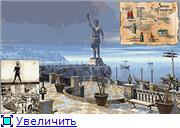
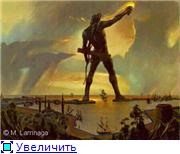
3. Faros lighthouse.
After the conquest of Egypt in 332 BC. Alexander the Great founded a city in the Nile Delta named after him - Alexandria.
During the reign of Ptolemy I, the city achieved wealth and prosperity, and the Alexandrian harbor became a bustling center of maritime trade.
As shipping developed, the helmsmen who brought ships with cargo to Alexandria increasingly felt the need for a lighthouse that would show ships a safe path among the shoals.
And in the 3rd century. BC. on the eastern tip of the island of Pharos, lying in the sea at a distance of 7 stadia (1290 m) from Alexandria, the architect Sostratus, son of Dexiphanes of Cnidus, built the famous lighthouse, which became one of the seven wonders of the Ancient World.
To transport building materials, the island was connected to the mainland by a dam. The work took only six years - from 285 to 279 BC.
Seeing this tower suddenly rising on a deserted island, contemporaries were shocked. From the list of seven wonders of the world, “miracle No. 2” - the walls of Babylon - was immediately crossed out, and its place was immediately taken by the Pharos lighthouse.
The lighthouse remained this way during Roman rule. According to Pliny the Elder, he shone “like a star in the darkness of the night.”
This monumental structure was at least 120 m high and its light was visible at a distance of up to 48 km.
According to Strabo, the lighthouse was built from local limestone and faced with white marble. Decorative friezes and ornaments are made of marble and bronze, columns are made of granite and marble. The lighthouse seemed to grow from the center of a spacious courtyard, surrounded by a thick fence, at the corners of which towered strong bastions, reminiscent of the pylons of ancient Egyptian temples. Numerous loopholes were cut into them, as well as throughout the entire wall.
The lighthouse itself consisted of 3 tiers.
The first one is square in plan (30.5x30.5 m). oriented to the cardinal points and lined with squares of white marble, it had a height of 60 m. Monumental statues depicting tritons were installed in its corners. Inside the first tier there were rooms for workers and security at different levels. There were also storerooms where fuel and food were stored.
On one of the side facades one could read the Greek inscription: “To the savior gods - for the salvation of sailors,” where the gods meant the king of Egypt Ptolemy I and his wife Berenice.
The smaller octagonal middle tier was also faced with marble slabs. Its eight faces were deployed in the directions of the prevailing winds in these places. At the top there were numerous bronze statues around the perimeter; some of them could serve as weather vanes indicating the direction of the wind. There is a legend that one of the figures followed the movement of the sun with an outstretched hand and lowered its hand only after it had set.
The upper tier had the shape of a cylinder and served as a lantern. It was surrounded by eight polished granite columns and topped by a cone-shaped dome topped by a 7-meter bronze statue of Isis Pharias, guardian of seafarers. Some researchers believe that there was a statue of Poseidon there.
Light signaling was carried out using a powerful lamp placed at the focus of concave metal mirrors. It is believed that fuel was delivered to the top by lifting mechanisms installed inside the tower - in the middle of the lighthouse there was a shaft leading from the lower premises upward to the lighting system.
According to another version, fuel was brought along a spiral ramp on carts drawn by mules.
It is believed that the upper part of the lighthouse (cylindrical, with a dome and a statue) collapsed in the 2nd century, but the lighthouse was still in operation in 641.
In the XIV century. The earthquake finally destroyed this masterpiece of ancient architecture and construction technology.
A hundred years later, the Egyptian Sultan Qait Bey ordered the construction of a fort on the remains of the lighthouse foundation, named after its creator.
Today we can judge the external appearance of the lighthouse only by its images on coins of Roman times and a few fragments of granite and marble columns.
In 1996, underwater archaeologists led by the famous French scientist Jean-Yves Emperer, founder of the Center for the Study of Alexandria, managed to find on the seabed the remains of the lighthouse structures that collapsed into the sea as a result of the earthquake.
This aroused great interest around the world.
In 2001, the Belgian government even took the initiative to recreate Faros lighthouse on the same spot where it was built 2200 years ago.
However, now the walls of the Qait Bay fortress still rise here, and the Egyptian government is in no hurry to agree to its demolition 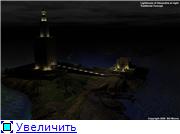
4. Temple of Artemis of Ephesus.
The oldest traces of the veneration of Artemis near her birthplace date back to pre-Greek times; The giant temple of the goddess was built in the 6th century. BC e. architect Khersiphron from Knossos. During one of the sieges, the inhabitants of Ephesus stretched a rope from the temple to the city, thereby turning it into an inviolable sanctuary.
The glory of Artemision was so great that people from all over the Greek ecumene placed their savings there.
Socrates' student, the famous historian Xenophon, who transferred a large sum of money to the goddess for safekeeping before going to Persia (described in Anabasis), upon his return, as a token of gratitude to Artemis, he built a small temple on it - an exact copy of the Ephesian one - in the town of Skillunte in Elis.
In 356 BC. e. The temple of Artemis of Ephesus, the main shrine of the Greeks of Asia Minor, was burned by Herostratus - a blasphemy was committed that shocked the entire Hellenic world.
Subsequently, a legend arose that Artemision burned down on the day when the future conqueror of Asia, Alexander the Great, was born. When Alexander approached the city, he wished to restore the temple in all its splendor.
The architect Alexandra Deinocrates, who supervised the work, retained its previous plan, only raised the building to a higher stepped base.
Dimensions of the structure:
The entire structure amazed with its magnificence and scale, unusual for Greek architecture. The temple occupied a huge area - 110 x 55 m, the height of the Corinthian columns (there were 127 of them), a double row surrounding the structure, was also grandiose - about 18 m
(according to legend, each of these columns was a gift from one of the 127 Greek kings);
The roof of Artemision was covered with almost human-sized reliefs decorated at the base.
Great Greek masters took part in decorating such a revered place: Praxiteles sculpted reliefs for the altar in the fence of the sanctuary, Scopas made the reliefs of the columns, Apelles placed his paintings in the temple;
The art gallery of Artemision enjoyed just as much fame as the collection of paintings in the Athenian Propylaea.
The sanctuary also flourished under the Romans; sources report rich donations of silver and gold statues to the temple and the construction of a portico along the road from the city to the sanctuary (approx. 200 m).
The Acts of the Apostles mentions the indignation that the preaching of the Apostle Paul caused in the city, which interfered with the trade in silver models of the temple of the goddess, the manufacture of which was the most profitable craft here.
Artemis Ephesus Temple in subsequent eras:
In 263, the Goths who burst into Asia Minor, hearing about the untold riches of the city and Artemision, plundered the sanctuary;
the next blow was the prohibition of pagan cults in the Roman Empire in 391 under Theodosius I the Great.
It is known, however, that the cult of Artemis continued to be held here for another two centuries, until the place was finally abandoned after the earthquake.
Gradually, they began to dismantle it into pieces and use it as a source of building materials for new buildings, the roof was also dismantled, and when the columns began to fall, their debris was sucked into the swamp on which the temple stood. The temple disappeared from the face of the earth and even the place where it stood was gradually forgotten.
In 1869, as a result of excavations begun by the English archaeologist J. T. Wood in a swamp at the supposed site of the sanctuary, the base slab of the structure was discovered and numerous offerings to the temple were found. The famous reliefs of the columns of Artemision are currently in the British Museum (London).
Now on the site of this “wonder of the world” there is only one single column. 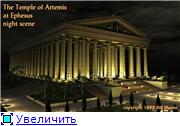
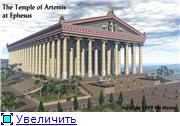
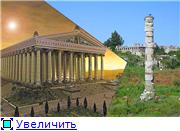
5. Egyptian pyramids, tombs of Egyptian pharaohs.
The largest of them - the pyramids of Cheops (Khufu), Khafre (Khafre) and Mekerin (Menkaure) in El Giza in ancient times were considered one of the Seven Wonders of the World.
The construction of the pyramid, in which the Greeks and Romans already saw a monument to the unprecedented pride of kings and cruelty that doomed the entire people of Egypt to meaningless construction, was the most important cult act and was supposed to express, apparently, the mystical identity of the country and its ruler.
The population of the country worked on the construction of the tomb during the part of the year free from agricultural work.
A number of texts testify to the attention and care that the kings themselves (albeit of a later time) paid to the construction of their tomb and its builders. It is also known about the special cult honors that were given to the pyramid itself.
The pyramids are lined up on the left - west bank Nile (West - the kingdom of the dead) and towered above everything city of the dead- countless tombs, pyramids, temples.
The largest of the three, the Cheops Pyramid, was built in the 27th century. BC e. Pharaoh Khufu (2590-2568 BC), architect Hemiun.
Its height was initially 147 m, and the length of the side of the base was 232 m. For its construction, 2 million 300 thousand huge stone blocks were required, the average weight of which was 2.5 tons.
The slabs were not held together with mortar, only extremely precise fitting held them in place.
In ancient times, the pyramids were faced with polished slabs of white limestone, their tops were covered with copper lites that sparkled in the sun (only the Cheops pyramid retained the limestone casing; the Arabs used the coating of other pyramids in the construction of the White Mosque in Cairo).
All pyramids are precisely oriented to the cardinal points, which indicates the high level of astronomical knowledge of the ancient Egyptians; the calculation of the angles of inclination of the faces is absolutely impeccable.
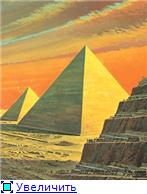
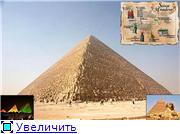
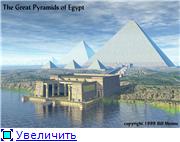
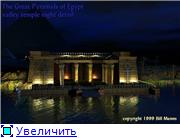
6. Hanging Gardens of Babylon.
In 1899, German archaeologist Robert Koldewey began excavations of the legendary Babylon.
One fine day, in the southern part of the city, he came across the remains of a very peculiar, completely unusual vaulted structure. Koldewey was puzzled. Firstly, during the entire period of excavations in Babylon, he encountered underground structures for the first time, and secondly, no one in Mesopotamia had ever encountered such a form of vault; thirdly, there was a well, consisting of three completely unusual shafts. Finally, fourthly, the vault was lined not only with brick, but also with stone, and the kind of stone that Koldewey had encountered only once among the ruins of Babylon - on the northern side of the Qasr region.
The totality of all the details made it possible to see in this building an extremely successful design for that time, both from the point of view of technology and architecture. Obviously, this structure was intended for some very special purposes. Koldewey suggested that in front of him were the remains of a water intake well with a ribbon water intake, which at one time was intended for a continuous supply of water. But where did the water go?
And then it dawned on Koldewey! He remembered that ancient sources - starting with the works of ancient writers Josephus, Ctesias, Strabo and ending with cuneiform tablets - contain only two references to the use of stone in Babylon: during the construction of the northern wall of the Qasr region and... during the creation of the “Hanging Gardens” of Babylon.
Thus, the remains of these famous gardens of the Seven Wonders of the World were revealed to archaeologists.
The Greeks called the legendary queen Semiramis, and her real name was Shammuramat. She lived approx. 800 BC After the death of her husband, King Shamshi-Adad V of Assyria, she took power into her own hands and ruled until her son Adad-Nerari III came of age.
During her reign, the state strengthened, and thanks to the conquest of Media, its borders reached the Caspian Sea. Even after her son ascended the throne, she retained the title of queen and her name was mentioned in the inscriptions of Beltarsiilima and on statues of the god Nabu next to the name of the king.
The name of Semiramis is associated with the Hanging Gardens of Babylon. However, according to other information, the hanging gardens were presented by Nebuchadnezzar II to his wife Amytis, the daughter of the Median king, and this happened 200 years after the death of Semiramis.
The first mention of wonderful gardens was preserved in the “History” of Herodotus, who visited Babylon and left us the most complete description of it. Perhaps, with an eye to the “father of history,” the hanging gardens (undoubtedly beautiful, were a kind of miracle of technology of that time, but no more) in the Hellenistic era were placed on the list of the greatest structures.
The gardens were located on a wide four-tier tower. The lower tier had the shape of an irregular quadrangle (42 m * 34 m). The terrace platforms were made of stone slabs, covered with a layer of reeds and filled with asphalt.
Next came gaskets made of two rows of bricks, fastened with plaster and lead slabs, which prevented water from entering the lower floors of the garden.
This entire complex structure was covered with a thick layer of fertile soil, which made it possible to plant the largest trees here. The tiers rose in ledges, connected by wide staircases with pink and white slabs.
Every day, thousands of slaves pumped water from deep wells at the top into numerous canals, from where it flowed to the lower terraces. The murmur of water, shade and coolness among the trees (brought from distant Media) seemed miraculous.
At its base, the structure rested on columns (up to 25 meters high) and ceilings forming vaults. 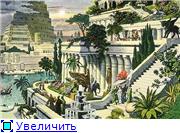
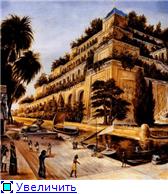
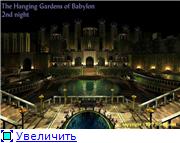
7. Mausoleum in Halicarnassus.
Mausolus was the ruler of Caria, part of the Persian Empire, from 377 to 353. BC.
The capital of the region was Halicarnassus, which became a tourist center in modern Turkey under the name Bodrum.
Mausolus succeeded his father as lord of the city and satrap of the province. Mausolus married his sister Artemisia. Gaining more and more power, he began to think about a tomb for himself and his queen. This must have been an extraordinary tomb.
Mausolus dreamed of a magnificent monument that would remind the world of his wealth and power long after his death.
Mausolus died before the tomb was completed, but his widow continued to supervise the construction until its completion, around 350 BC.
The tomb was called Mausoleum, after the king, and this word came to mean any impressive and majestic tomb.
The building originally combined the eastern step pyramid and the Greek Ionic peripter (architects Satyr and Pytheas).
Like other Greek monuments from among the Seven Wonders of the World, the Mausoleum was famous not only for the grandeur of its architecture, but also for its collection of sculptures - the base of the pyramid, on which a Greek-type temple and another pyramid rested, was decorated with reliefs with scenes of Amazonomachy by the most famous sculptors of the 4th century. BC e. - Leochares, Scopas, Briaxis and Timothy.
Dimensions and description of the structure:
The architects built a tomb for the tyrant of Halicarnassus in the form of an almost square building, the first floor of which was the actual tomb of Mausolus and Artemisia.
Outside this huge burial chamber, pl. 5000 sq. m. and height approx. 20 m., was lined with slabs of white marble, hewn and polished in the Persian style. Along the top of the first floor there was a frieze - the battle of the Hellenes with the Amazons - “Amazonomachy” by the great Skopas.
The second floor, surrounded by a colonnade, housed sacrifices. The roof of the mausoleum was a pyramid topped with a marble quadriga: in a chariot drawn by four horses stood the statues of Mausolus and Artemissia.
Pliny describes this structure as follows:
“From the south and north, its length is 63 feet, from the front and back sides it is narrower, the total length is 440 feet, it reaches a height of 25 cubits, and is surrounded by 36 columns. This coverage was called pteron...above the pteron rises a pyramid, equal in height to the lower part, tapering in twenty-four steps into a pointed meta. At the top there is a marble quadriga, which was created by Pytheas. Together with it, the entire structure reaches a height of 140 feet (46 m).”
The mausoleum marked the decline of classical Greek art. Apparently he was too rich and formal to be truly handsome. Even in reconstruction drawings it seems as heavy and static as Persian tombs - it has more of the East than Greece
Perhaps the reason for this is the pyramid, perhaps the blank high walls of the lower floor (for the first time in Greek art, all three famous orders were combined: ground floor supported by fifteen Doric columns, the inner columns of the upper floor being Corinthian and the outer Ionic).
The mausoleum stood in the center of the city, descending to the sea. Therefore, from the sea it was visible from afar and looked advantageous next to the other temples of Halicarnassus - the colossal sanctuary of Ares, the temples of Aphrodite and Hermes, which stood higher on the hill, on the sides of the mausoleum.
After 18 centuries, an earthquake destroyed the Mausoleum to the ground.
In 1489, the Knights of St. John used its ruins to build St. Peter's Castle. After the knights were expelled by the Turks from the coast of Asia Minor, the castle was turned into the Bodrum fortress (modern Bodrum in Turkey).
In the middle XIX century European travelers noticed that marble slabs with antique reliefs were embedded in the wall of the fortress.
After lengthy and persistent efforts, the English ambassador in Turkey managed to obtain permission to break down these slabs and transport them to London. Experts from the British Museum have come to the conclusion that in front of them is the famous frieze of Skopas, which once adorned the tomb of King Mausolus.
In 1857, British archaeologist C. T. Newton, having carried out excavations at the site where the Mausoleum once stood, found relief slabs from the base of the tomb, statues of Mausolus, etc. Today they are kept in the Halicarnassus Hall of the British Museum in London and the Archaeological Museum in Istanbul.
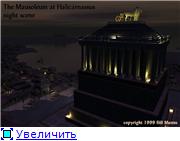
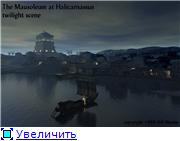
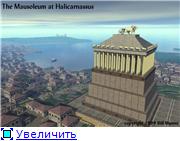
The Seven Wonders of the World (or the Seven Wonders of the Ancient World) is a list of the most famous cultural attractions of the part of the world developed by mankind. The choice of number itself is sanctified by ancient ideas about its completeness, completeness and perfection; the number 7 was considered the sacred number of the god Apollo (Seven against Thebes, Seven Wise Men, etc.). Like collections of sayings of famous sages, collections of anecdotes and stories of wonders, writings on the Seven Wonders of the World were popular in ancient times and included descriptions of the grandest, most magnificent, or technically most amazing buildings and monuments of art. That's why they were called miracles, while many genuine masterpieces are missing from the list ancient architecture and art - the Acropolis in Athens with the creation of Phidias - the statue of Athena Parthenon, the famous statue of Aphrodite of Knidos by Praxiteles, etc.
The “selection” of miracles occurred gradually, and some miracles replaced others.
The first list of wonders of the world is attributed to Herodotus. The list appeared in Ancient Greece in the 5th century BC. e.. All the miracles were on the island of Samos. This listing consisted of three wonders of the world:
Aqueduct in the form of a tunnel,
Dam in the port on the island,
Temple of the goddess Hera.
Historians associate this list with the empire of Alexander the Great.
Currently, the Seven Wonders of the World include:
|
Miracle |
Time of creation |
Place |
Creators |
Destruction |
Cause |
Purpose of the structure |
|
The Pyramid of Cheops |
2540 BC e. |
Giza (Egypt) |
Egyptians |
the only “miracle” that has survived to this day |
tomb of pharaoh Cheops |
|
|
Hanging Gardens of Babylon |
600 BC e. |
Babylon (Iraq) |
Babylonians |
After the 1st century BC. e. |
floods destroyed the foundation and the structure collapsed |
They were created for the wife of King Nebuchadnezzar II. |
|
Zeus statue in Olympia |
435 BC e., sculptor Phidias |
Olympia(Greece) |
burned in Constantinople during a fire at the Hippodrome in the 5th century. |
temple statue in the Temple of Zeus at Olympia |
||
|
Temple of Artemis at Ephesus |
550 BC e. |
Ephesus (Türkiye) |
Lydians, Greeks, Persians |
370 BC e. 356 BC e. (Herostratus) or 262 AD. e. (gothami) |
was built in honor of the goddess Artemis |
|
|
Mausoleum in Halicarnassus |
351 BC e., architect Pytheas |
Halicarnassus (in southwest Turkey) |
Carians, Persians, Greeks |
earthquake; preserved: foundations, architectural fragments; in the British Museum in London - statues of Mausolus and his wife Artemisia, reliefs, statues of lions |
was erected as a tombstone for the Carian ruler Mausolus by his wife, Queen Artemisia |
|
|
The Colossus of Rhodes |
between 292 and 280 BC e. |
Rhodes (Greece) |
224 (or 226) BC e. the bronze body was dismantled in 654 AD. e. |
earthquake |
was installed by the sculptor Chares to perpetuate the memory of the victory of Rhodes over Demetrius Poliorcetes (304 BC). |
|
|
Alexandrian lighthouse |
III century BC e. |
Alexandria(Egypt) |
GreeksPtolemaic dynasty |
303 BC e. - 1480 AD e. (stood 1783) |
earthquake |
the light of this lighthouse was very useful for navigation. |
The Seven Wonders of the World (or the Seven Wonders of the Ancient World) is a famous list of the most famous sights of ancient culture. Compiling a list of the most famous poets, philosophers, generals, great kings, as well as monuments of architecture and art is a traditional “minor” genre of Greek Hellenistic poetry and a kind of exercise in rhetoric. The very choice of number is sanctified by the most ancient ideas about its completeness, completeness and perfection; the number 7 was considered the sacred number of the god Apollo (Seven against Thebes, Seven Wise Men, etc.). Like collections of sayings of famous sages, collections of anecdotes and stories of wonders, essays on the Seven Wonders of the World were popular in ancient times and included descriptions of the grandest, most magnificent or technically most amazing buildings and monuments of art. That is why they were called miracles, while the list does not include many genuine masterpieces of ancient architecture and art - the Acropolis in Athens with the creation of Phidias - the Parthenon statue of Athena, the famous statue of Aphrodite of Knidos by Praxiteles, etc.
1. Pyramid of Cheops.
Pyramid of Cheops (Khufu) - the largest of Egyptian pyramids, the only one of the “Seven Wonders of the World” that has survived to this day. It is assumed that construction, which lasted twenty years, began around 2560 BC. e. Dozens of Egyptian pyramids are known. On the Giza plateau, the largest of them are the pyramids of Cheops (Khufu), Khafre (Khafre) and Mikerin (Menkaure). Architect Great Pyramid Hemiun, vizier and nephew of Cheops, is considered. He also bore the title "Manager of all Pharaoh's construction projects." More three thousand years (before construction cathedral in Lincoln, England, around 1300), the pyramid was the tallest building on Earth.
Statistical data.
Height (today): 138.75 m
Side face angle: 51 50
Side length (original): 230.33 m (calculated) or about 440 Royal cubits
Side length (currently): about 225 m
The length of the sides of the base of the pyramid: south - 230.454 m; north - 230.253 m; west - 230.357 m; east - 230.394 m.
Foundation area (initially): 53,000 m
Area of the pyramid: (originally) 85,500 m
Perimeter: 922 m.
Total volume of the pyramid without deducting the cavities inside the pyramid (initially): 2.58 million m
Total volume of the pyramid, after subtracting all known cavities (initially): 2.50 million m
Average size of observed stone blocks: 1.0 m in width, height and depth (but most are rectangular in shape.)
Average weight of stone blocks: 2.5 tons
Heaviest stone block: 15 t
Number of blocks: about 2.5 million.
According to estimates, the total weight of the pyramid: about 6.25 million tons
The base of the pyramid rests on a natural rocky elevation in the center about 9 m high.
The pyramid is called "Akhet-Khufu" - "Horizon of Khufu" (or more accurately "Related to the sky - (it is) Khufu"). Consists of blocks of limestone, basalt and granite. It was built on a natural hill. Despite the fact that the Cheops pyramid is the tallest and most voluminous of all the Egyptian pyramids, yet Pharaoh Sneferu built the pyramids in Meidum and Dakhshut (Broken Pyramid and Pink pyramid), the total mass of which is estimated at 8.4 million tons. This means that 2.15 million tons were used to build these pyramids. or 25.6% more material than was required for the Cheops pyramid. Initially, the pyramid was lined with white limestone, which was harder than the main blocks. The top of the pyramid was crowned with a gilded stone - the pyramidion. The facing shone in the Sun with a peach color, like “a shining miracle to which the Sun God Ra himself seemed to give all his rays.” In 1168 AD. e. The Arabs sacked and burned Cairo. Residents of Cairo removed the cladding from the pyramid in order to build new houses.
2. Hanging Gardens of Babylon. 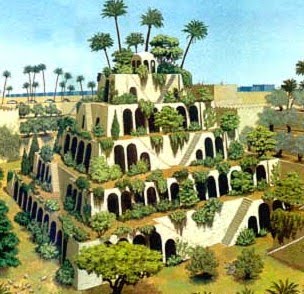 The Hanging Gardens of Babylon are one of the Seven Wonders of the World. The correct name of this structure is the Hanging Gardens of Amytis: this was the name of the wife of the Babylonian king Nebuchadnezzar, for whose sake the gardens were created.
The Hanging Gardens of Babylon are one of the Seven Wonders of the World. The correct name of this structure is the Hanging Gardens of Amytis: this was the name of the wife of the Babylonian king Nebuchadnezzar, for whose sake the gardens were created.
The Babylonian king Nebuchadnezzar II (605-562 BC), in order to fight against the main enemy - Assyria, whose troops twice destroyed the capital of the state of Babylon, entered into a military alliance with Cyaxares, the king of Media. Having won, they divided the territory of Assyria among themselves. Their military alliance was confirmed by the marriage of Nebuchadnezzar II to the daughter of the Median king Amytis. Dusty and noisy Babylon, located on a bare sandy plain, did not please the queen, who grew up in mountainous and green Media. To console her, Nebuchadnezzar ordered the construction of hanging gardens. The Hanging Gardens existed for about two centuries. First, they stopped caring for the garden, then powerful floods destroyed the foundation of the columns, and the entire structure collapsed.
Architecturally, the hanging gardens were a pyramid consisting of four tiers-platforms. They were supported by columns up to 25 meters high. The lower tier had the shape of an irregular quadrangle, the largest side of which was 42 m, the smallest - 34 m. To prevent the seepage of irrigation water, the surface of each platform was first covered with a layer of reeds; fertile soil lay on them in a thick carpet, where seeds of various herbs, flowers, and shrubs were planted and trees. The pyramid resembled an ever-blooming green hill. Pipes were placed in the cavity of one of the columns. Day and night, hundreds of slaves turned a lifting wheel with leather buckets, delivering water to the gardens. Magnificent gardens with rare trees, fragrant flowers and coolness in sultry Babylonia were truly a wonder of the world. But during the Persian rule, Nebuchadnezzar's palace fell into disrepair. It had 172 rooms, decorated and furnished with luxury. Now Persian kings occasionally stayed there during inspection trips throughout the vast empire. But in the 4th century this palace became the residence of Alexander the Great. The throne room of the palace and the chambers of the lower tier of the hanging gardens were last place Alexander's stay on earth.
3. Temple of Artemis in Ephesus.
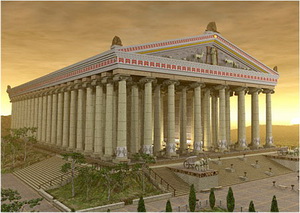 The Temple of Artemis at Ephesus, one of the Seven Wonders of the Ancient World, was located in the Greek city of Ephesus on the coast of Asia Minor (currently the city of Selcuk in the south of Izmir Province, Turkey). The first large temple was built in the middle of the 6th century BC. e., burned by Herostratus in 356 BC. e., soon restored in a rebuilt form, in the 3rd century destroyed by the Goths.
The Temple of Artemis at Ephesus, one of the Seven Wonders of the Ancient World, was located in the Greek city of Ephesus on the coast of Asia Minor (currently the city of Selcuk in the south of Izmir Province, Turkey). The first large temple was built in the middle of the 6th century BC. e., burned by Herostratus in 356 BC. e., soon restored in a rebuilt form, in the 3rd century destroyed by the Goths.
Inside, the temple was decorated with wonderful statues by Praxiteles and reliefs by Skopas, but even more magnificent were the paintings of this temple. So, in gratitude to Alexander the Great (who sponsored the project), the Ephesians commissioned a portrait of him for the temple by the artist Apelles, who depicted the commander with lightning in his hand, like Zeus. When the customers came to accept the canvas, they were so amazed by the perfection of the painting and the optical effect (it seemed that a hand with lightning was protruding from the canvas) that they paid the author twenty-five gold talents - perhaps over the next three centuries, no artist was able to receive such a fee for one picture.
4. Statue of Zeus at Olympia.
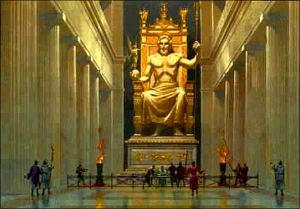 The statue of Olympian Zeus is the work of Phidias. Outstanding work antique sculpture, one of the seven wonders of the world. It was located in the Temple of Olympian Zeus, in Olympia - a city in the Elis region, in the north-west of the Peloponnese peninsula, where from 776 BC. e. to 394 AD e. every four years were held Olympic Games- competitions between Greek and then Roman athletes. The Greeks considered those who did not see the statue of Zeus in the temple unfortunate.
The statue of Olympian Zeus is the work of Phidias. Outstanding work antique sculpture, one of the seven wonders of the world. It was located in the Temple of Olympian Zeus, in Olympia - a city in the Elis region, in the north-west of the Peloponnese peninsula, where from 776 BC. e. to 394 AD e. every four years were held Olympic Games- competitions between Greek and then Roman athletes. The Greeks considered those who did not see the statue of Zeus in the temple unfortunate.
The Olympic Games have been held for over 300 years. They were very popular among the people. They were held in honor of the god Zeus. But in Greece, the main temple in honor of Zeus has not yet been erected. In 470 BC. e. in Greece they began to collect donations for the construction of this temple.
According to legend, the temple was magnificent. The entire temple, including the roof, was built of marble. It was surrounded by 34 massive columns made of shell rock. Each was 10.5 meters high and more than 2 meters thick. The area of the temple was 64x27 m
5. Mausoleum in Halicarnassus.
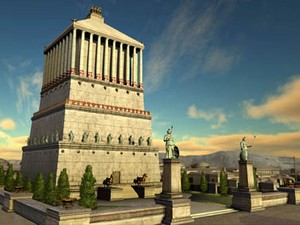 Halicarnassus Mausoleum is a tombstone of the Carian ruler Mausolus, built in the middle of the 4th century BC. e. by order of his wife Artemisia II in Halicarnassus (modern Bodrum, Turkey), one of the ancient wonders of the world.
Halicarnassus Mausoleum is a tombstone of the Carian ruler Mausolus, built in the middle of the 4th century BC. e. by order of his wife Artemisia II in Halicarnassus (modern Bodrum, Turkey), one of the ancient wonders of the world.
The mausoleum stood for 19 centuries. In the 13th century it collapsed from a strong earthquake, and in 1522 the remains of the Mausoleum were dismantled by the Knights of St. John for the construction of the fortress of St. Petra. In 1846, the ruins were explored by an expedition from the British Museum led by Charles Thomas Newton. Based on the results of the research, several options for reconstructing the original appearance were compiled, one of which was used as the basis for the Grant Mausoleum in Manhattan.
6. Colossus of Rhodes.
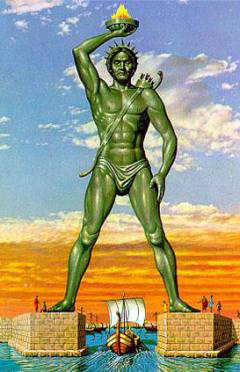 The Colossus of Rhodes - giant statue the ancient Greek sun god Helios, which stood in the port city of Rhodes, located on the island of the same name in the Aegean Sea, Greece. One of the "Seven Wonders of the World".
The Colossus of Rhodes - giant statue the ancient Greek sun god Helios, which stood in the port city of Rhodes, located on the island of the same name in the Aegean Sea, Greece. One of the "Seven Wonders of the World".
After the collapse of the power of Alexander the Great, Peoletius gained a foothold in Rhodes. After his establishment in Egypt, he concluded an alliance with Rhodes to control trade in the eastern Mediterranean. In 305 BC e. the son of another diadoch, Antigonus I One-Eyed, Demetrius I of Macedon, landed on Rhodes with an army of forty thousand. Having held main city The islands were under siege for a whole year, despite the construction of many siege weapons, he was forced to retreat due to the Ptolemaic fleet approaching Rhodes. The people of Rhodes decided to sell their abandoned siege weapons and build a statue of their revered sun god Helios to thank him for his intercession. Helios was not just a particularly revered deity on the island - according to legend, he was its creator: not having a place dedicated to him, the sun god carried the island in his arms from the depths of the sea.
The sculptor Hares, a student of Lysippos, worked for twelve years to create an almost 36-meter bronze giant. When the work on the statue was completed, a tall and slender young god with a radiant crown on his head appeared before the eyes of the amazed Rhodians. He stood on a white marble pedestal, leaning slightly back, and intensely peered into the distance. The statue of the god stood right at the entrance to the harbor of Rhodes and was visible from the nearby islands. The statue was made of clay, had a metal frame at its base, and was covered with bronze sheets on top. To work on the image of the god directly at the site of its installation, Hares used an original technique: with the gradual elevation of the sculpture, the earthen hill around it also rose; the hill was subsequently torn down, and the statue in its entirety was revealed to the astonished inhabitants of the island. The production of the grandiose monument required 500 talents of bronze and 300 talents of iron (about 13 and about 8 tons, respectively). The colossus also gave rise to a kind of fashion for giant statues in Rhodes already in the 2nd century. BC e. About a hundred colossal sculptures were installed.
The colossus stood for sixty-five years. In 222 BC. e. The statue was destroyed by an earthquake. As Strabo writes, “the statue lay on the ground, overthrown by an earthquake and broken at the knees.” But even then the Colossus caused surprise with its size. Pliny the Elder mentions that only a few could clasp the statue's thumb with both hands. The remains of the Colossus lay on the ground for more than a thousand years, until they were finally sold by the Arabs, who captured Rhodes in 977, to a merchant who, as one chronicle says, loaded 900 camels with them. There was a legend: when the statue of the Colossus of Rhodes was erected, an earthquake occurred, after which it collapsed. The statue was restored again, and again there was an earthquake. The sages said that if the people erected the statue again, the island of Rhodes would go under water.
7. Alexandria Lighthouse.
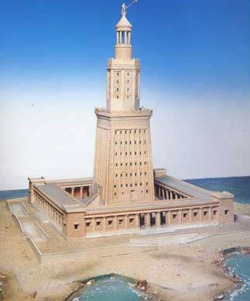 The Alexandria Lighthouse is one of the 7 wonders of the world, built in the 3rd century BC. e. in the Egyptian city of Alexandria, so that ships could safely pass the reefs on the way to the Alexandria Bay. At night they were helped in this by the reflection of flames, and during the day by a column of smoke. It was the world's first lighthouse, and it stood for almost a thousand years, but in 796 AD. e. was severely damaged by the earthquake. Subsequently, the Arabs who came to Egypt tried to restore it, and by the 14th century. the height of the lighthouse was about 30 m. At the end of the 15th century. Sultan Qait Bey erected a fortress on the site of the lighthouse, which still stands today.
The Alexandria Lighthouse is one of the 7 wonders of the world, built in the 3rd century BC. e. in the Egyptian city of Alexandria, so that ships could safely pass the reefs on the way to the Alexandria Bay. At night they were helped in this by the reflection of flames, and during the day by a column of smoke. It was the world's first lighthouse, and it stood for almost a thousand years, but in 796 AD. e. was severely damaged by the earthquake. Subsequently, the Arabs who came to Egypt tried to restore it, and by the 14th century. the height of the lighthouse was about 30 m. At the end of the 15th century. Sultan Qait Bey erected a fortress on the site of the lighthouse, which still stands today.
The lighthouse is a high tetrahedral tower with a fire on top, the light of which is reflected by mirrors on the sea so that ships sailing to Alexandria do not run into the reefs. The first level of the building has painted walls, the second level has high and long columns and a cylindrical wall-staircase, the third level is the most important, with a fire and mirrors located on it.
The total height of the lighthouse is 120-140 meters, its light was visible at a distance of 60 km (according to other evidence, up to 100 km). The lower part was a tetrahedral prism 60 meters high with a square base, the side length of which was 30 m. Various equipment was stored in the interior, and a flat roof, decorated at the corners with huge statues of Triton, served as the basis of the middle part. It was a 40-meter octagonal prism tower, lined with white marble. The upper (third) part of the lighthouse was built in the form of a cylindrical colonnade - 8 columns carried a dome topped with an 8-meter bronze figure of the ruler of the seas, Poseidon (or a statue of Zeus the Savior).
By the 12th century AD. e. Alexandria Bay became so filled with silt that ships could no longer use it. The lighthouse fell into disrepair. The bronze plates that served as mirrors were probably melted down into coins. In the 14th century, the lighthouse was completely destroyed by an earthquake. A few years later, the Arab Turks used its ruins to build a military fortress. The fortress was subsequently rebuilt several times.
Why exactly the Seven Wonders of the World, and not 9 or 12. It all depends on the magical properties of the number 7. In ancient times, it was believed that seven was the most perfect and complete number. Only the best could be included in this quantity, which could not be more than 7. Therefore, of all the greatest architectural monuments of antiquity, only a small fraction of them were classified as miracles.
No one will argue that many creations of human hands surpassed the selected seven wonders in their magnificence and perfection. But capricious fate decided so. She bypassed some masterpieces with her attention, and gave it excessively to others. Who made the will of fate come true? In the 1st century BC. e. lived Greek historian Strabo. It was he who compiled the final list, which previously had many different options, starting from the time of Herodotus, who lived in the 5th century BC. e.
Strabo's list has survived 2 thousand years. During all this time, he was never challenged by anyone. At least official history does not know such facts. But since people have agreed with the ancient historian for such a long time, then we can only humbly bow our heads and consider those miracles that are generally recognized by all mankind.
Let's pay tribute to the woman, therefore, as true gentlemen and well-mannered ladies, let's begin to consider the Seven Wonders of the World from the Temple of Artemis.
This is what the Temple of Artemis looked like
Temple of Artemis
Who is Artemis? This is always the young goddess of hunting and fertility. She personified female purity and chastity. It was from her that the ancient Greek women asked for help during childbirth and happiness in marriage. She was revered throughout the territory Balkan Peninsula And west coast Asia Minor. The popularity of the eternally young goddess was enormous. According to ancient Greek mythology, she was conceived from the love affair of Zeus and the goddess Leto. The latter had the status of a lover outside of marriage, while the proud Hera was considered the wife of the Thunderer.
She created many obstacles for her rival and even tried to prevent her from giving birth. But Leto still gave birth to two children from Zeus. They were born on the same day: brother and sister - twins. It was Artemis and Apollo. Artemis was born an hour earlier, so she was considered an older sister.
It was for her that the sentimental ancient Greeks erected a huge temple of pure white marble. It was built in the city of Ephesus in the first half of the 6th century BC. e. A seaside city, it was located on the western coast of Asia Minor. At that time, these lands belonged to Lydia. Quite a large state that occupied almost half of the territory of Asia Minor.
King Croesus reigned there. He was considered the richest ruler at that time. There is a saying associated with his name: “Rich as Croesus.” The king allocated money from the treasury for the construction of a huge temple. It reached 100 meters in length and 18 meters in height. Its width was 50 meters. There were 127 marble columns. They supported the roof. It is unknown what the sculpture of Artemis herself looked like. According to legend, it was made of ivory, and the goddess’s sandals were made of pure gold.
But elephant tusks are a rather inconvenient material. Therefore, they were soaked in vinegar for a long time until the bone became soft. Then each tusk was stratified into many thin strips and given the desired shape. On clean air the strips hardened and again acquired all the properties of ivory. This is how the sculpture was created, the beauty of which can only be guessed at.

This is what the Temple of Artemis looked like inside. A statue of the goddess is visible behind the columns
The architect of the temple is considered to be the Greek Hersifron. Construction took several decades. Other people were already finishing the work. The chronicles mention the names Paeonius and Demetrius. The majestic structure has delighted people for more than a hundred years. But in 356 BC. e. On the night that Alexander the Great was born, the Temple of Artemis was set on fire.
Someone committed this sacrilege Herostratus. He was a citizen of the city of Ephesus, and in age he was a very young man. He was captured and brutally tortured. Under torture, Herostratus admitted that he set fire to the temple for the sake of glory. He wanted his name to live on for centuries.
This man was driven by ambition, and the priests tried to do everything possible to make Herostratus forgotten. In all cities of the Mediterranean it was forbidden to mention this name under penalty of cruel punishment. The ancient Greek historian Theopompus, a contemporary of those distant events, mentioned the name cursed by everyone in his works. Subsequently, Strabo got acquainted with them, and also called the arsonist by name. Thus, Herostratus was not forgotten. He is well known today, being a symbol of sick ambition bordering on madness.
The burnt temple of Artemis was restored. Alexander the Great took an active part in this. He allocated money and found a good architect. It turned out to be Heirocrates. But the new building, of course, was already worse than the old one. It was inferior in size, and marble was combined with stone. The golden sandals disappeared from the sculpture’s feet. The yellow metal was replaced with ivory.
In the 3rd century AD greatest creation human hands were plundered by the Goths. The temple fell into disrepair after that. In the 4th century it was destroyed and rebuilt Christian Church. All the marble was stolen for personal use, and the remaining columns collapsed. All traces of the once huge structure have disappeared.
In 1869, the English archaeologist Wood discovered the foundations of the Temple of Artemis. It was possible to reassemble and restore one column from the wreckage. Nowadays, only it reminds of the former greatness of one of the Seven Wonders of the World.
Hanging Gardens of Babylon
The Hanging Gardens of Babylon are also included in the list of Seven Wonders of the World. This architectural creation was located in the city of Babylon, and was created during the reign of King Nebuchadnezzar II. He ruled the Kingdom of Babylon from 605 to 562 BC. e. The Hanging Gardens are mentioned only by Strabo. No other ancient historian wrote a word about them.
Whether they really existed or not is difficult to say. Nowadays, not only there are no gardens, but even Babylon itself. After the death of Alexander the Great, the city very quickly fell into decay. It was located 110 km south of Baghdad and for 1500 years was considered one of the most beautiful and largest cities Ancient world. The gardens were located on the territory of the royal palace next to the Euphrates River.
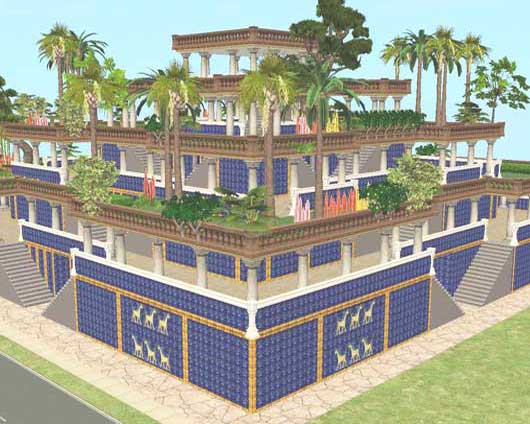
This is what the Hanging Gardens of Babylon looked like
As Strabo describes, they were created by order of the king after the victory over Assyria. Nebuchadnezzar II entered into an alliance with Media - a state located between Mesopotamia and the Caspian Sea - and married the daughter of the Median king. The girl's name was Amytis. But large city did not please the young wife. It was dusty, noisy and in no way resembled the greenery of Mussel.
Amitis felt homesick. And then the almighty king ordered the creation of magnificent gardens and planting in them green plants from the places where his wife spent her youth. The ruler's order was carried out.
We do not know the name of the architect or how long it was built architectural masterpiece. Only the structure of the gardens itself is known, as well as the technical means by which the green spaces were watered.
High above the ground there was a 4-step pyramid. It was supported by columns dug into the ground. The height of the columns was 20 meters. At this height from the ground was the lowest of the steps. Each of them was a wide platform. The floor was covered with reeds. A thick layer of fertile soil was laid on it. It was in it that flowers, shrubs and trees brought from Media were planted.
From the side, the pyramid resembled a huge green hill among the sandy plain on which the city of Babylon stood. Water came from the waters of the Euphrates to the topmost pyramid using hand pumps. Hundreds of slaves were involved. They pumped water around the clock, and it flowed through pipes hidden in the columns. On the pyramid itself, the builders made artificial stream beds. The water, murmuring, ran down them to the first tier. This is how the plants were watered.
The Gardens of Babylon were grandiose building, both architecturally and technically. Taking into account the cheap slave labor at that distant time, it was quite possible to erect such a construction masterpiece. Only one thing is unclear - why were the gardens named after the Assyrian queen? Moreover, Semiramis was not a historical person, but a mythological one.
Her prototype was the Assyrian queen Shammuramat. She lived in the 9th century BC. e. and ruled as a strong military power. But what did this woman have to do with Babylon? It would be easier to call the Hanging Gardens the gardens of Babylon or the gardens of Nebuchadnezzar, but they received a completely different name at the behest of the ancient Greek historian Strabo.
Be that as it may, but in 539 BC. e. a mighty power has fallen. The Achaemenids conquered it and created a huge Persian Empire. Their capital was initially the city of Pasargadae under Cyrus the Great, and then the city of Persepolis received this status under Darius I. Babylon remained out of business, and therefore royal palace together with the Gardens of Babylon, it fell into decay.
Very rarely did the Persian kings once visit great city. They stopped watering the green vegetation and it withered. The palace was empty and dilapidated. Alexander the Great breathed life into it, making Babylon the capital of his empire in the 4th century BC. e.
But the prosperous period lasted only a few years. The great conqueror died in a room that was located just under the lowest tier of the once hanging gardens. After this, not only the gardens, but the entire city rapidly fell into decay.
2.5 thousand years have passed. Naturally, no traces of one of the Seven Wonders of the World remained. Only the manuscript of Strabo reminds us of the Hanging Gardens. But his story is more like a beautiful fairy tale than historical truth. However, any fairy tale can become reality. There is a lot of evidence of this in history.
mausoleum in Halicarnassus
The Seven Wonders of the World are inextricably linked with the mausoleum at Halicarnassus. Halicarnassus is a city in historical region Kariya. It is located on the coast Mediterranean Sea in the southwestern part of Asia Minor. Today, on the site of Halicarnassus is the Turkish city of Bodrum. And in the 4th century BC. e. the Achaemenid satrapy was located in these places. It was she who was ruled by King Mausol (377-353 BC).
Although he was considered a satrap, he did not experience any oppression from the Persian rulers. This gave the king the opportunity to accumulate untold wealth by collecting huge tribute from his subjects. But where to put the money? So Mavsol decided to build himself a giant tombstone. In this he was warmly supported by his wife and sister Artemisia. At that time, incest was widespread among the reigning dynasties. It was considered simply unthinkable to mix your “semi-divine” blood with blood of a lower quality.
Therefore, siblings have always been married. Sometimes this had a fatal effect on the children, and the dynasty degenerated. But often the opposite happened. Incest did not in any way affect the health of the rulers, and healthy and strong offspring were born. Apparently Mavsol and Artemisia belonged to just such a group of people. They were absolutely healthy, except that they were overly vain. But this is typical for most of the powerful and has no connection with consanguineous marriages.
![]()
General view of the mausoleum in Halicarnassus
Construction of the mausoleum began in last years life of Mausolus. After his death, Artemisia supervised the work. The most famous architects and sculptors of that time were involved in the construction of the tomb. This is Pytheas - a brilliant architect who combines the talent of a sculptor. Leochares is a sculptor who later became a court sculptor at the court of Alexander the Great. It was he who created the statue of Apollo Belvedere - the most perfect human body, in which all proportions were perfectly observed.
It should also be mentioned famous sculptor Skopasa. He achieved perfection in creating marble sculptures. Moreover, Skopas was the first to depict the mental state of his creations. This was emphasized by a frowning forehead, wrinkles, and lips. Such a talented team worked on the creation of the mausoleum in Halicarnassus.
Naturally, the building turned out to be majestic. It was an almost square structure, built of baked brick and faced with marble. Its length was 38 meters, width - 32 meters. The height of the architectural masterpiece reached 40 meters.
The base was a huge rectangle. On top there were 400 sculptures. Behind the sculptures stood 39 columns. Their height reached 11 meters. They surrounded the peripterus - the tomb. The roof was a pyramid. It had a stepped shape. There were 24 steps in total. All this splendor was crowned by a quadriga. It was a marble chariot drawn by four horses. The chariot contained sculptures of Mausolus and Artemisia. The quadriga reached 6 meters in height. Thus, the total height of the mausoleum was 46 meters.
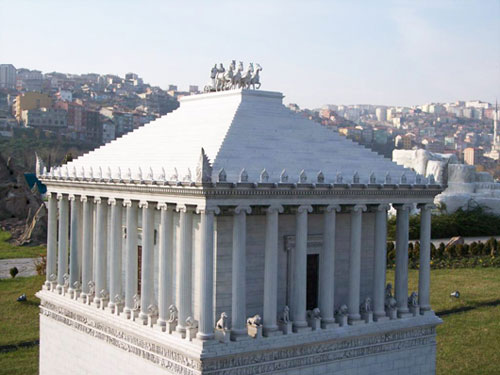
This is what the upper part of the mausoleum in Halicarnassus looked like
This building was in no way similar to the architectural structures of that time. Therefore, he was named after Mavsol - mausoleum. Over time, the name has changed somewhat. Nowadays, such buildings are called mausoleums.
The mausoleum at Halicarnassus stood for 1800 years. In the 13th century it was destroyed by a powerful earthquake. After 200 years, the building material of the structure was used by the Knights of the Order of Malta to erect a defensive structure - the fortress of St. Petra. In the mid-19th century, the ruins were explored by scientists from England. They compiled several versions of the original appearance of the mausoleum. It is very difficult to say which of them exactly coincided with the actual one.
Zeus statue in Olympia
Olympia is the greatest historical place, located in the north-west of the Peloponnese. It combined a city and a sanctuary. It was there that from 776 BC. e. to 394 AD e. The Olympic Games were held every 4 years. They covered a huge historical period of more than 1000 years. First the ancient Greeks and then the ancient Romans competed in their sports skills. Olympic champions were revered almost like gods, and Zeus was considered the main patron of the Olympics.
The games took place one after another, but there was no majestic temple dedicated to the Thunderer. Only at the beginning of the 5th century BC. e. The ancient Greeks finally decided to build a temple near the site of the Olympic Games. The structure was built in the middle of the 5th century BC. e. pretty quickly. Everything took 10 years.
The temple was built from poros (a soft type of stone - in this case white marble-like limestone was used), and marble plaster was applied on top. The length of the building was 66 meters. The width was 27 meters. And the height of the temple reached 18 meters. The structure was truly majestic, but it lacked the most important thing - the statue of Zeus.
For 20 years the temple stood without the Thunderer. Finally people raised money and invited them to Olympia famous sculptor Fidia. First of all, he was notable for being a friend of Pericles, the father of Athenian democracy.
The statue was not sculpted in the temple itself. To create it, a special workshop was built, the height of which exactly corresponded to the height of the temple. In it, Phidias created his masterpiece, which became one of the Seven Wonders of the World.
How the statue was then dragged into the temple is unknown. Perhaps the structure was dismountable, and it was brought in parts. Strabo and other ancient historians do not provide any information on this issue. So let's leave this question unanswered.
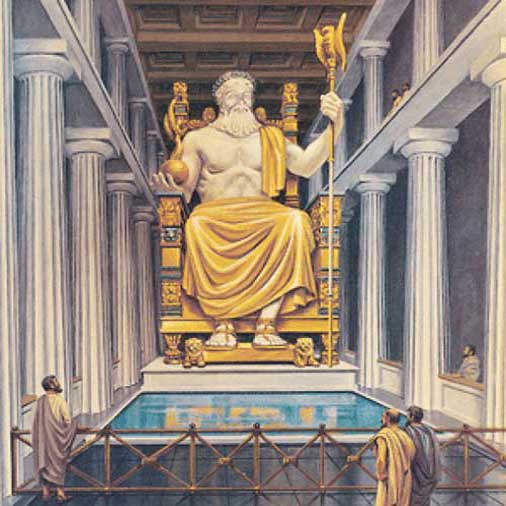
Zeus statue in Olympia
Also depicted is a pool that reflected sunlight
Zeus statue in Olympia reached a height of 12 meters and depicted the Thunderer sitting on a throne. The figure was made of ivory. A wreath of gold rested on the god's head. The right hand of the celestial held Nike (the goddess of victory, akin to the Roman Victoria). His left hand clutched a scepter on which a golden eagle sat. The sculptor shod Zeus’s feet in golden sandals, and depicted animals and flowers on the god’s cloak.
The main material of the throne was marble. In visible places it was covered with mahogany, decorated with gold. Nicky “danced” near the legs. There were 16 of them in total - 4 for each leg. Directly in front of the statue was a rectangular pool filled with water. Olive oil was poured into it, and it formed a thin film on the surface of the liquid. Sunlight fell on the film, reflected and illuminated the top of the sculpture. It seemed as if the statue was emitting a glow. This optical effect brought people into a state of complete delight.
The temple and statue of Zeus at Olympia were badly damaged during a major earthquake in the 2nd century BC. e. After this, the greatest building was restored, but in the 4th century AD. e. Christians closed it. They didn't need pagan cults. The building was gradually stolen for personal use. The golden details of the sculpture were the first to disappear.
At the very beginning of the 5th century, everything that remained of the statue was transported to Constantinople. It is unclear where the historical value was kept there. But at the end of the fifth century, one of the greatest sculptures of human civilization was destroyed by fire. What kind of fire it was, in which temple it was - there is no information about this.
The Seven Wonders of the World and the Colossus of Rhodes are an inextricable whole. This masterpiece was a huge bronze statue, which, according to legend, towered right at the entrance to the bay port city Rhodes. The prerequisite for the creation of a huge structure was the war. In 305 BC. e. the city was besieged by Macedonian troops. For a whole year, the inhabitants of Rhodes repelled the attacks of the invaders. They were numerous and armed with siege weapons. But the townspeople survived. The enemy retreated in disgrace.
The courageous defenders attributed the victory not only to their steadfastness, but also to the help of Helios, the god of the Sun. The people decided that without him they would not have been able to defeat the Macedonians. In accordance with traditions, the celestial being should be thanked. And the townspeople decided to build a huge statue of God. They were not poor people, as they were engaged in trade, so they collected the necessary money and invited the Greek sculptor Chares.
He erected a huge statue, called the Colossus of Rhodes. Its construction began at the very beginning of the 3rd century and lasted 12 years. All work was completed approximately in 280 BC. e.
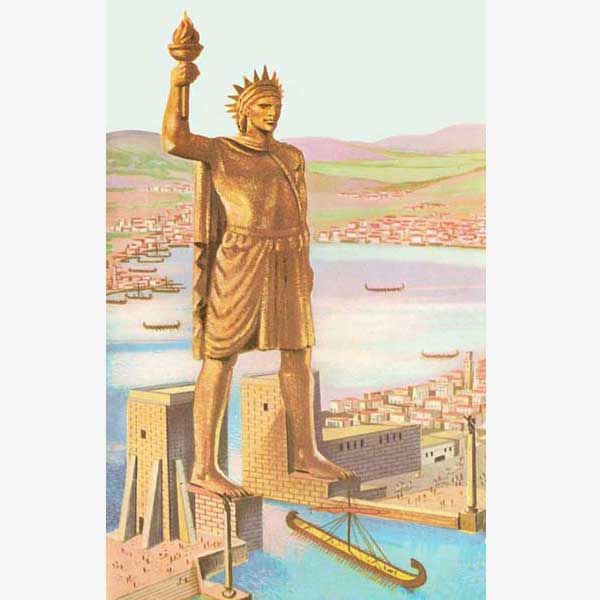
This is how the Colossus of Rhodes was imagined in the Middle Ages
The construction was grandiose. The height of the statue was about 30-35 meters. The frame was made of iron, clay and stone, and the top was covered with bronze. The Sun God Helios stood on a marble pedestal, the height of which reached 5 meters. On the head of the celestial there was a crown with rays. How many rays there were is unknown. Taking into account the pedestal, the structure reached a height of at least 36-38 meters.
But people did not admire the Sun God for long. 60 years have passed, and a powerful earthquake shook the coastal lands of the island of Rhodes. The tremors affected the Colossus of Rhodes in the saddest way. The giant statue broke at the knees and collapsed directly onto residential buildings. Several houses were destroyed in the process.
A pile of stones, bronze and iron lay on the ground for a very long time. At first, people wanted to raise the statue, but it was so huge that the initiators eventually abandoned their idea. As a result, the material began to be gradually taken away. As legends say, the last stones remaining from the Colossus were taken away in the 10th century. But this is hard to believe. Most likely, all the material was stolen in a maximum of 100 years. People had to live, build, and here is a pile of ownerless stone, iron and bronze.
Everything is clear with construction and destruction. But there is still no answer to one of the most important questions - where exactly did the Colossus of Rhodes stand?
Many historians, who have never seen the huge statue, claim that it was located right at the entrance to the bay. That is, ships sailed past it. In the Middle Ages, there was an opinion that the Colossus rested its feet on two opposite shores, and the ships fell into the bay, bypassing the space between the legs.
All this hardly seems true. As already mentioned, the statue took 12 years to build. At the same time, a mound of earth was made around it. The Colossus rose up, and the height of the embankment also increased. Then all the earth was removed and the site was leveled.
Everyone understands that if such work were organized in the bay, they would completely paralyze it for more than 10 years. But the city of Rhodes was one of the most important shopping centers Ancient world.
Therefore, the giant statue of the Sun God did not stand at the entrance to the bay. Where then? There are two most likely places capable of hosting a majestic structure. This is the fortress of St. Nicholas and the Temple of Helios.
The fortress today is located at the end of the pier, the construction of which dates back to the ancient era. It is quite possible that in the 3rd century BC. e. This is where the Colossus of Rhodes stood. But there is one small “but”. Ancient historians claimed that when the statue fell, it destroyed residential buildings. There have never been any of these on the pier. Therefore, the huge structure stood in a different place.
The Temple of Helios is considered an ideal piece of land. It was located on a hill deep in the city. These days it is the Street of the Knights of John. The Palace of the Grand Masters is located on it. Previously, there was a fortress built here by the Byzantines. But just before it stood the temple of the Sun God, who was considered the patron saint of the city.
Next to him, Hares installed a huge statue. It was perfectly visible from the sea. There were residential buildings around it. During the earthquake when the Colossus fell, it destroyed part of the residential buildings. That is, this place completely coincides with the descriptions that ancient historians set out in their works.
The Lighthouse of Alexandria was the greatest building of the Ancient World. It stood for 16 centuries and is rightfully considered one of the Seven Wonders of the World. It was erected in the 3rd century BC. e. during the reign of the Ptolemaic dynasty.
The construction of the lighthouse was preceded by the emergence of the city of Alexandria in the Nile River Delta. It was founded by Alexander the Great in 332 BC. e. After the death of the great conqueror, power in Egypt was taken into his own hands by Ptolemy Lag, one of the military leaders of Alexander the Great.
This man undoubtedly had great intelligence. He initiated the Library of Alexandria and ordered the construction of a huge lighthouse near the city. Sailors must have seen the majestic structure from many tens of kilometers away. That is, according to the ruler’s idea, the lighthouse was primarily supposed to serve as a guide for sailors.
Even today, the coast of Alexandria would not be visible from the sea if not for the high-rise buildings. A similar situation was observed in ancient times. Ship crews could search for the city for a week. Therefore, the construction of a lighthouse was a vital task.
They erected a huge structure on the island of Foros, and connected it to the shore with a man-made embankment (dam). The length of the dam was 1.3 km. Its construction took about 15 years. The Alexandria Lighthouse itself was built in 5 years. The architect was Sostratus of Cnidus. The lighthouse started operating in 280 BC. e. already under the son of Ptolemy Lagus Ptolemy II.
What was the greatest architectural creation? These are 3 stone towers, placed one on top of the other. The lower tower rested on red Aswan granite. The structure itself was made of limestone and lined with white marble.
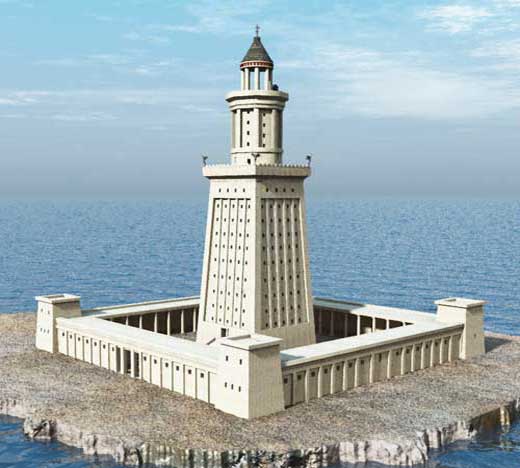
Model of the Alexandria Lighthouse
The lower tower had a quadrangular shape and reached a height of 60 meters. The length of each side was 30 meters. Along the edges of the tower stood statues of Triton, the son of Poseidon and Amphitrite. The middle tower was octagonal. Its height was 40 meters. The upper tower was round in shape. It was crowned with a domed roof. On it stood a bronze statue of Poseidon. This is the ancient Greek god of the seas. The dome was supported by eight columns.
The entire height of the structure reached 130-140 meters. But some historians give a different figure. They insist on a height of 180 meters. These days it is difficult to say anything on this issue. Only one thing is clear - the lighthouse was significantly higher than 100 meters.
A fire was lit on the top tower at night, and a column of smoke rose during the day. The service staff numbered hundreds of people. It was a whole production. But it was worth the money that was invested in it. After all, thanks to the lighthouse, merchant ships easily reached the port of Alexandria. And this is a duty, trade turnover, and therefore a profit, and a very impressive one at that.
The Alexandria lighthouse regularly performed its functions until 956, when a strong earthquake occurred. The damage was extensive, but the majestic structure was repaired. The next earthquake occurred in the 14th century. It completely destroyed the lighthouse and turned it into ruins.
But the huge structure ceased to perform its immediate functions in the 11th century. The point was that ships stopped entering the bay, as it was covered with silt. At the end of the 15th century, the ruins of the great man-made creation served as material for the construction of a Turkish fortress. Currently, this place is used by the Egyptian armed forces for their needs.
Great Pyramids of Giza
And finally, the Great Pyramids of Giza. These are the only buildings from the Seven Wonders of the World that have survived to this day. Of course, their appearance is rather unpresentable, but we must take into account that 45 centuries have passed, and this is a huge period of time even by historical standards.
The wonders of the world include 3 pyramids. The Pyramid of Cheops, the Pyramid of Khafre and the very modest-looking Pyramid of Mikerin. Actually, it is not each individual pyramid that is considered a miracle, but the entire complex. It is striking in its size and causes a lot of controversy over the methods of constructing majestic structures.
Some researchers are of the opinion that the complex was built by some other, more developed civilization. They motivate this by the fact that the technology for processing stone blocks does not correspond to the technical achievements that existed 45 centuries ago.
The majestic complex is located on the Giza plateau and is 25 km from the center of Cairo. The biggest is the Pyramid of Cheops. Its original height was 146 meters. Today it is 138 meters.
Pyramid of Khafre had an original height of 143 meters. Today there are 136 meters in stock. That is, it is slightly inferior to the tomb of Pharaoh Cheops.
Pyramid of Mikerin- this is a baby compared to its more majestic brothers. Its original height was 65 meters. Now only 62 meters are observed.
Where did the tops of the Egyptian buildings go? Each of them was crowned pyramidion. This is a miniature pyramid. According to legend, all 3 pyramidions were made of pure gold. Therefore, it is not difficult to assume that they were simply stolen. Over the course of 45 centuries, there have been desperate heads who were not afraid of enormous heights.
But, most likely, the crowning structures were made of granite, polished and gilded. Although, who knows, it is quite possible that they were 100% yellow metal.
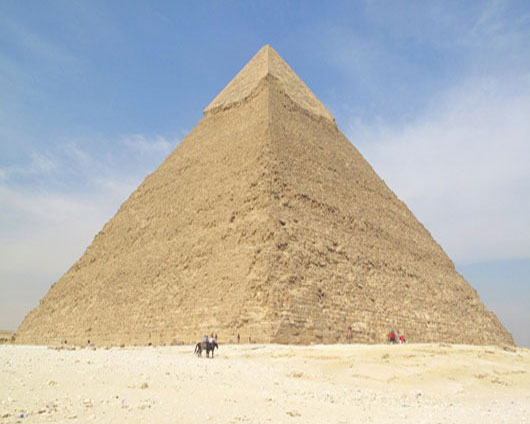
One of the Great Pyramids at Giza
Remains of white cladding on top are visible
On top, the pointed stone structures were faced with white limestone slabs. To date, all this material has been stolen. It was stolen by the residents of Cairo to build their houses. Only at the very top of the Pyramid of Khafre there are pitiful remains of the once luxurious cladding.
How were the huge structures built? There are so many people, so many opinions. It is assumed that stone blocks, weighing 2-3 tons, were dragged to the top along a ramp (earthen embankment). But what this ramp was like is anyone's guess.
Let's imagine a height of 140 meters. You need to drag a 3-ton stone block onto it. Therefore, the embankment should have the same height with a minimum angle of inclination of approximately 7 degrees. And what length could it be? That is, the dimensions of the ramp exceeded the dimensions of the structure under construction.
The builders could have made the embankment not straight. For example, it went around the perimeter of the pyramid. But in any case, its size was impressive, and because of the huge earth mound, the tomb was simply not visible. All this seems too cumbersome, inconvenient, clumsy, and is unlikely to have actually taken place.
There are many other assumptions, but they all suffer from serious flaws. Thus, we can conclude that modern history doesn't know how the Great Pyramids of Giza were built. It's a shame, a shame - but it's a fact.
History also does not know what technologies were used in processing stone blocks. All of them are perfectly adjusted to each other and have absolutely smooth surfaces. So there are only riddles and questions with no answers.
Other pyramids of Ancient Egypt, although they were built much later, were built using primitive technologies. They were assembled from poorly processed stones and baked bricks, which were bound together with mortar. Everything is explained here simply and easily. Nowadays, these man-made creations look like shapeless heaps and do not in any way resemble majestic structures.
I would like to draw your attention to one more strange detail. The pyramid is the tomb of the pharaoh. But, for example, in the same pyramid of Cheops the mummy of the formidable ruler was not found. Apparently she was never there at all. So why did people disfigure themselves for 20 years, building something that was absolutely useless at first glance? stone structure. All of the above can be described as the greatest mysteries of history. So amazing discoveries are yet to come.
So we've looked at Seven wonders of the world. Each of them individually represents a masterpiece of ancient architecture and has every right to be called a miracle. This once again proves that our distant ancestors were brilliant masters. They created beautiful man-made creations, and it is a pity that modern man cannot admire them. It's all due to merciless time. Only he has the power to destroy. But in this non-stop flow, new masterpieces are created, not much inferior to the majestic buildings of fabulous antiquity.
